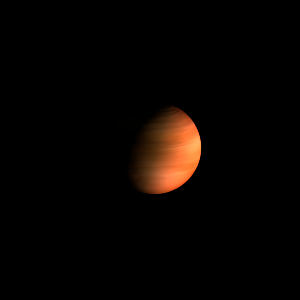|
|
Space Astro
|
Info for exoplanet "Kichi"
| Scientific (actual) data |
|---|
| Name | NGTS-4 b |
| Planet status | Confirmed |
| Planet mass | 0.0648 |
| Radius | 0.2837 |
| Orbital period | 1.33735 |
| Semi major axis | 0.019 |
| Orbit eccentricity | 0 |
| Inclination | 82.5 |
| Discovered | 2018 |
| Updated | 2018-09-29 |
| Tzero tr | 2457610 |
| K | 13.7 |
| Temperature (kelvin) | 1650 |
| Publication | Published in a refereed paper |
| Detection type | Primary Transit |
| Mass measurement type | Radial Velocity |
| Radius measurement type | Primary Transit |
| Star name | NGTS-4 |
| Right ascension | 89.6° |
| Declination | -30.81° |
| Mag v | 13.14 |
| Star distance | 282.6 |
| Star metallicity | -0.28 |
| Star mass | 0.75 |
| Star radius | 0.84 |
| Star temperature | 5143 |
| Wikipedia article | NGTS-4 b |
Back
| |
| Fictional info (?) |
|---|
| Suggested name | Kichi |
| Planet type | Small hot gas planet |
| Having almost no atmosphere to retain heat, it has surface temperatures that vary diurnally more than on any other planet in its solar system, ranging from 130°K (-143°C) at night to 945°K (672°C) during the day across the equatorial regions.
The smooth Borealis basin in the northern hemisphere covers 15 percent of the planet and may be a giant impact feature.
The volume of water ice in the south polar ice cap, if melted, would be sufficient to cover the entire planetary surface to a depth of 9 meters. |
| Atmosphere | Ammonia | 58% |
| Ozone | 17% |
| Carbonyl sulfide | 14% |
| Carbon monoxide | 10% |
| Ethane | 0.79% |
| Atmospheric pressure | 0.05 bar |
 |
| Moon | Jahyumu | Huge round oceanic moon |
| Fudame Kyote | Very small slightly egg-shaped crater-filled moon |
| Mobya | Very small round ice asteroid |
| Parya'eshu | Medium-sized round gaseous comet |
| Jukyu Re | Very small round rocky moon |
| Myopa | Large almost round ice comet |
| Google search for Kichi |
|
Website by Joachim Michaelis
|
|
|
|